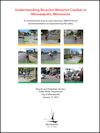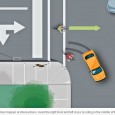 The city of Minneapolis, Minnesota recently released a report, Understanding Bicyclist-Motorist Crashes, that offers “A comprehensive look at crash data from 2000-2010 and recommendations for improved bicyclist safety”.
The city of Minneapolis, Minnesota recently released a report, Understanding Bicyclist-Motorist Crashes, that offers “A comprehensive look at crash data from 2000-2010 and recommendations for improved bicyclist safety”.
As you might expect, there is a lot of data to digest, but a few points jumped out:
- Approximately one out of five crashes are hit-and-runs.
- Bicyclists sustained an injury in 87.0 percent of crashes. It is estimated that motorists sustained an injury in no crashes.
- Forty-one percent of crashes occur at intersections and another 40 percent occur within 50 feet of
intersections. - There is a clear correlation between the number of bicyclists and the crash rate. As the number of bicyclists has increased over the past decade, the crash rate has decreased. On streets and corridors with higher volumes of bicycle traffic, the crash rate tends to be lower than on streets with lower volumes of bicycle traffic.
- It appears that bicyclists and motorists are equally contributing to the causes of crashes.
- Most crashes are occurring at intersections along major arterials. Motorists are not seeing or yielding to bicyclists. Bicyclists are not riding in a predictable manner.
Some of this is familiar stuff, if you’ve been paying attention. The “Safety in Numbers” phenomenon — the more bicyclists there are, the safer each of them is — has been widely reported around the nation. A study in California, for instance, concluded that “a motorist is less likely to collide with a person walking and bicycling when there are more people walking or bicycling”.
 And the finding that most crashes occur at or near intersections is also not a surprise; that’s been long understood, and is a primary reason that most experienced cyclists control the lane at intersections, making themselves more visible, and making it less likely that motorists will deliberately or inadvertently violate their right-of-way. (Image courtesy of Bicycle Federation of Wisconsin.)
And the finding that most crashes occur at or near intersections is also not a surprise; that’s been long understood, and is a primary reason that most experienced cyclists control the lane at intersections, making themselves more visible, and making it less likely that motorists will deliberately or inadvertently violate their right-of-way. (Image courtesy of Bicycle Federation of Wisconsin.)
The hit-and-run statistics are the most troubling:
Twenty-one percent of bicyclist-motorist crashes are hit-and-runs. Bicyclists are disproportionately
the victims of hit-and-run crashes. Detailed analysis of 800 accident reports from 2006-2008 found that of bicycle-related hit-and-run crashes, motorists fled 92.8 percent of the time and bicyclists fled 7.2 percent.
That is one reason that there was a Tougher Hit-and-Run Law Passed in Kansas two years ago. The law “makes it a felony, with presumptive prison time, for a driver to leave the scene of an accident that involves a fatality or major injuries.”
Has it made a difference? Perhaps too soon to tell. I spoke with the District Attorney in one small Kansas county recently, and he said that the new law had been successfully used to prosecute drivers who’d hit-and-run other motor vehicles in his county, but thankfully, the issue had not yet come up with a bike/ped hit-and-run.
Another eye-popping statistic: “From 2000-2010 the cost of bicyclist-motorists crashes is estimated to be between $63.7 to $320.0 million.”
Thank about that: All that money wasted, all those lives lost, all those bodies horribly injured. All that carnage. For what? Speed over safety?
The report does draw some conclusions: “The city’s busy streets and intersections were not originally designed for bicycle traffic. Bicyclists are relatively new to modern roadways and not all motorists have come to expect them. And lastly, the lack of designated space and the large number of novice riders likely contribute to the large number of unpredictable maneuvers by bicyclists.”
The “not all motorists have come to expect them” line sounds like totally unnecessary excuse-making for poor drivers, but the last line makes a lot of sense: Provide safe places for bicyclists, and bicyclists (whether experienced or novice) will be safer.
See also: Happy trends in Minneapolis bicycling: Commutes are way up, collisions down
Post tags: NewsBlog

